
A pika is a small, mountain-dwelling mammal native to Asia and North America. With short limbs, a very round body, an even coat of fur, and no external tail, they resemble their close relative, the rabbit, but with short, rounded ears. The large-eared pika of the Himalayas and nearby mountains lives at elevations of more than 6,000 m (20,000 ft).

Tapirus is a genus of tapir which contains the living tapir species. The Malayan tapir is usually included in Tapirus as well, although some authorities have moved it into its own genus, Acrocodia.
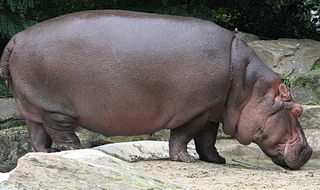
Hippopotamus is a genus of artiodactyl mammals consisting of one extant species, Hippopotamus amphibius, the river hippopotamus, and several extinct species from both recent and prehistoric times. It belongs to the family Hippopotamidae, which also includes the pygmy hippopotamus and a number of extinct genera.

Asio is a genus of typical owls, or true owls, in the family Strigidae. This group has representatives over most of the planet, and the short-eared owl is one of the most widespread of all bird species, breeding in Europe, Asia, North and South America, the Caribbean, Hawaii and the Galápagos Islands. Its geographic range extends to all continents except Antarctica and Australia.

Cuvieronius is an extinct New World genus of gomphothere which ranged from southern North America to western South America during the Pleistocene epoch. Among the last gomphotheres, it became extinct at the end of the Pleistocene, approximately 12,000 years ago, following the arrival of humans to the Americas.

Glossotherium is an extinct genus of large mylodontid ground sloths of the subfamily Mylodontinae. It represents one of the best-known members of the family, along with Mylodon and Paramylodon. Reconstructed animals were between 3 and 4 metres long and possibly weighed up to 1,002.6–1,500 kg. The majority of finds of Glossotherium date from the Middle and Upper Pleistocene, around 300,000 to 10,000 years ago, with a few dating older, as far back Pliocene, about 3.3-3 million years ago. The range included large parts of South America, east of the Andes roughly from latitude 20 to 40 degrees south, leaving out the Amazon Basin in the north. In western South America, finds are also documented north of the equator. The animals largely inhabited the open landscapes of the Pampas and northern savanna regions.

The little red brocket or swamp brocket, also known as the Ecuador red brocket, is a small, little-studied deer native to the Andes of Colombia, Ecuador and northern Peru, where found in forest and páramo at altitudes between 1,400 and 3,600 metres. It is one of the smallest brocket deer. The coat is reddish, and the legs and crown are blackish. As recently as 1999, some authorities included both the pygmy brocket and Merida brocket as subspecies of the little red brocket.

The tawny-throated dotterel is a species of bird in the family Charadriidae, the plovers and their relatives. It is found in Argentina, Bolivia, Brazil, Chile, Peru, and Uruguay.

Caracara is a genus in the family Falconidae and the subfamily Polyborinae. It contains one extant species, the crested caracara; and one extinct species, the Guadalupe caracara. The South American Classification Committee of the American Ornithological Society has voted to again merge the two, retaining C. plancus as crested caracara. The taxonomists of the International Ornithologists' Union have also merged them.
Desmodus draculae is an extinct species of vampire bat that inhabited Central and South America during the Pleistocene, and possibly the early Holocene. It was 30% larger than its living relative the common vampire bat. Fossils and unmineralized subfossils have been found in Argentina, Mexico, Ecuador, Brazil, Venezuela, Belize, and Bolivia.
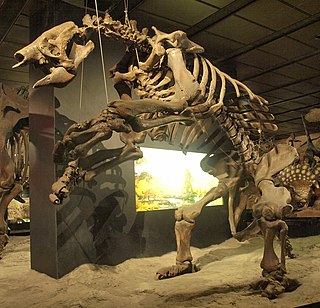
Eremotherium is an extinct genus of giant ground sloth in the family Megatheriidae. Eremotherium lived in the southern North America, Central America, and northern South America from the Pliocene, around 5.3 million years ago, to the end of the Late Pleistocene, around 10,000 years ago. Eremotherium was widespread in tropical and subtropical lowlands and lived there in partly open and closed landscapes, while its close relative Megatherium lived in more temperate climes of South America. Both genera reached the size of today's elephants and were among the largest mammals in the Americas. Characteristic of Eremotherium was its robust physique with comparatively long limbs and front and hind feet especially for later representatives- three fingers. However, the skull is relatively gracile, the teeth are uniform and high-crowned. Like today's sloths, Eremotherium was purely herbivorous and was probably a mixed feeder that dined on leaves and grasses. Eremotherium was a generalist that could adapt its diet to the respective local and climatic conditions of many regions. Finds of Eremotherium are common and widespread, with fossils being found as far north as South Carolina in the United States and as far south as Rio Grande Do Sul, and many complete skeletons have been unearthed.

Catonyx is an extinct genus of ground sloth of the family Scelidotheriidae, endemic to South America during the Pliocene and Pleistocene epochs. It lived from 2.5 Ma to about 10,000 years ago, existing for approximately 2.49 million years. The most recent date obtained is about 9600 B.P.
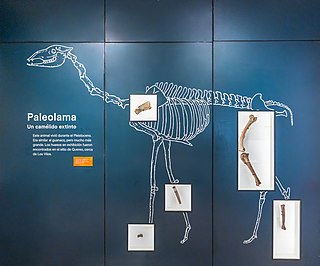
Palaeolama is an extinct genus of laminoid camelids that existed from the Late Pliocene to the Early Holocene. Their range extended from North America to the intertropical region of South America.

Chelonoidis is a genus of turtles in the tortoise family erected by Leopold Fitzinger in 1835. They are found in South America and the Galápagos Islands, and formerly had a wide distribution in the West Indies.

Dama is a genus of deer in the subfamily Cervinae, commonly referred to as fallow deer.
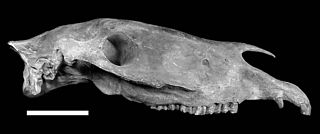
Equus neogeus is an extinct species of equine native to South America during the Pleistocene. It was formerly thought to be several distinct species within the subgenus Amerhippus, but was later shown to be a single morphologically variable species. It is thought to be closely related to true horses.
Protopithecus is an extinct genus of large New World monkey that lived during the Pleistocene. Fossils have been found in the Toca da Boa Vista cave of Brazil, as well as other locales in the country. Fossils of another large, but less robust ateline monkey, Caipora, were also discovered in Toca da Boa Vista.
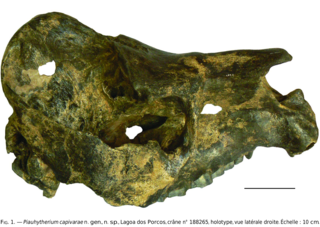
Piauhytherium is an extinct genus of herbivorous notoungulate mammal of the family Toxodontidae. It lived during the Late Pleistocene; fossils have been found in Brazil. The only known species is Piauhytherium capivarae.
Caipora is an extinct genus of large New World monkey that lived during the Pleistocene. It contains a single species, Caipora bambuiorum. Fossils have been found only in Brazil's Toca da Boa Vista cave, alongside the larger Protopithecus. The presence of these two large arboreal monkeys in Bahia suggests that the region may have supported a dense forest during the Late Pleistocene.

Oreomylodon is an extinct genus of ground sloth in the family Mylodontidae, endemic to Ecuador during the Pleistocene. The only species, O. wegneri, was long considered to be either a species or subgenus of Glossotherium or a junior synonym of Glossotherium robustum, but studies of its cranial anatomy published in 2019 have supported Oreomylodon as a valid genus, and suggested it is more closely related to Paramylodon. However, a subsequent analysis published in 2020 again sunk Oreomylodon wegneri into Glossotherium, as a distinct species. It shows adaptations to living in a high-altitude habitat, and its fossils have frequently been unearthed in the Interandean Valles of Ecuador, at elevations of between 2,450 and 3,100 meters.




















